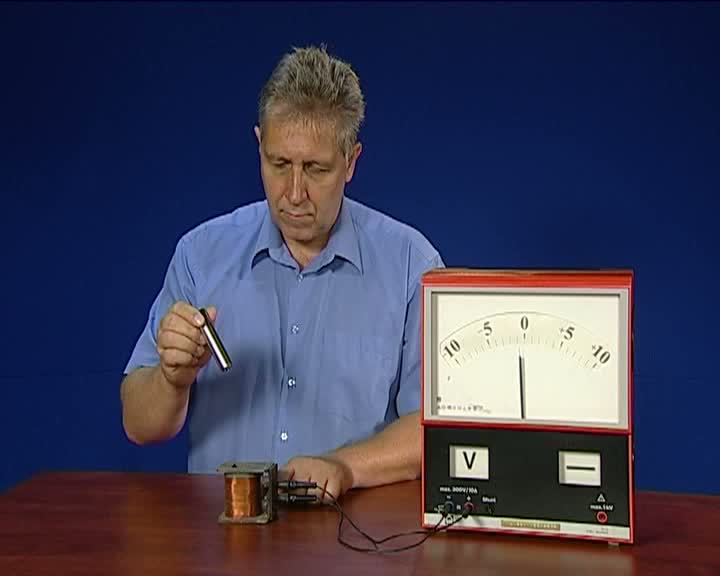„Mágneses indukció VI.” változatai közötti eltérés
| (egy szerkesztő 4 közbeeső változata nincs mutatva) | |||
| 6. sor: | 6. sor: | ||
Adott egy sokmenetű tekercs, végeivel egy voltmérőhöz csatlakoztatva. Egy erős rúdmágnessel elég közelíteni a tekercs tengelyéhez, hogy a műszer feszültséget jelezzen. A mágnes tekercsbe tolásának sebességével monoton nő a mért feszültség. Ugyanez igaz ellenkező polaritással a mágnes tekercsből történő kivételénél. Időben változatlan indukciófluxus zérus feszültséggel jár, legyen bármilyen nagy ez az időben állandó fluxus. | Adott egy sokmenetű tekercs, végeivel egy voltmérőhöz csatlakoztatva. Egy erős rúdmágnessel elég közelíteni a tekercs tengelyéhez, hogy a műszer feszültséget jelezzen. A mágnes tekercsbe tolásának sebességével monoton nő a mért feszültség. Ugyanez igaz ellenkező polaritással a mágnes tekercsből történő kivételénél. Időben változatlan indukciófluxus zérus feszültséggel jár, legyen bármilyen nagy ez az időben állandó fluxus. | ||
| − | == | + | == Magnetic induction VI. == |
| − | + | ||
| − | + | ||
| + | Given a multithread reel connected to a voltmeter, it is sufficient to approach a strong magnet bar to the axis of the reel to produce voltage. If the magnet is pushed inside the reel, the voltage is increased and is portional to the speed of the bar’s motion. The same holds with opposite polarity for pulling the bar out of the reel. A flux constant in time produces no voltage, independant of magnitude. | ||
</wikitex> | </wikitex> | ||
A lap jelenlegi, 2013. július 1., 13:05-kori változata
Az elhangzó szöveg
Adott egy sokmenetű tekercs, végeivel egy voltmérőhöz csatlakoztatva. Egy erős rúdmágnessel elég közelíteni a tekercs tengelyéhez, hogy a műszer feszültséget jelezzen. A mágnes tekercsbe tolásának sebességével monoton nő a mért feszültség. Ugyanez igaz ellenkező polaritással a mágnes tekercsből történő kivételénél. Időben változatlan indukciófluxus zérus feszültséggel jár, legyen bármilyen nagy ez az időben állandó fluxus.
Magnetic induction VI.
Given a multithread reel connected to a voltmeter, it is sufficient to approach a strong magnet bar to the axis of the reel to produce voltage. If the magnet is pushed inside the reel, the voltage is increased and is portional to the speed of the bar’s motion. The same holds with opposite polarity for pulling the bar out of the reel. A flux constant in time produces no voltage, independant of magnitude.
